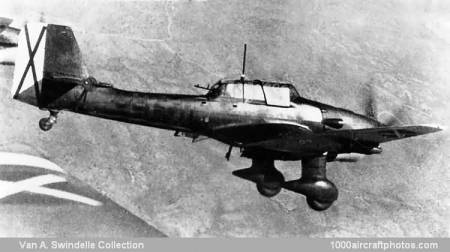11/30/2010. Early in 1938, a standard Ju 87A-1 was taken from the Dessau production line, fitted with an 1,000 hp Jumo 211A engine, and redesignated Ju 87 V6. This was followed by a more extensively modified machine, the
Ju 87 V7, intended as the forerunner of the Ju 87 B production aircraft. The machine had an entirely redesigned cockpit canopy, enlarged vertical tail surfaces, spats in place of trouser fairings, and an additional MG 17 gun in the port wing.
Ten pre-production Ju 87 B-0s were produced later in 1938, followed by the generally-similar B-1. Four variants of the basic model were produced: the standard Ju 87 B-1/U1, the B-1/U2 with alternative radio equipment, the
B-1/U3 with additional armour protection, and the B-1/U4 with skis in place of the standard wheeled landing gear. The Ju 87B-1/Trop was fitted with desert survival equipment.
The Ju 87 B-1 was replaced on the production line late in 1939 by the improved B-2 which was powered by the 1,200 hp Jumo 211Da engine with direct fuel injection. The machine had hydraulically-operated radiator cooling gills and modified landing gear legs and could carry a 1,000 kg (2,200 lb) bomb load. The Ju 87 B-2/U1, U2, U3 and U4 were respectively similar modifications to those of the B-1 described earlier.
With the introduction of the Ju 87 B, production of the machine was transferred from Dessau to the Weser-Flugzeugbau GmbH at Berlin-Tempelhof, and later Bremen-Lemwerder; Junkers remaining responsible for the development of new sub-types. During 1937 and 1938 only 395 Ju 87s were built, production being increased to 557 in 1939 and 611 in 1940.
One of the features of the Ju 87 was the siren mounted in a fairing in the upper leading edge of each landing gear leg. These were initially a simple
structure operated by air passing through them during a high-speed dive. Later a more elaborate system was introduced where the sirens were driven by small airscrews mounted in the nose of the special fairing. The purpose of these sirens was to add to the psychological effect of the dive-bomber, proving particularly menacing in the terror bombing of civilians.
The Ju 87 C was a special conversion of the dive-bomber intended for operation from the aircraft carrier Graf Zeppelin which was under construction at Kiel. A batch of Ju 87 C-0 pre-production aircraft left the Weser factory during the summer of 1939. This variant was fitted with a jettisonable landing gear, was stressed for catapulting and carried an arrester hook forward of the tail wheel. A small number of Ju 87 C-1s with electrically-folding wings were laid down later in the year, but were converted to B-2 standard when work on the Graf Zeppelin was temporarily abandoned.
In October 1938, five of the first production Ju 87 B-1s were sent to Spain and proved even more successful than the Ju 87 A-1s which had preceded them. Pictured is a Stuka of the Nationalist Spanish AF in action over central Spain. The aircraft was painted in the new black-green, dark-green splinter camouflage. The underside was sprayed light-blue.
